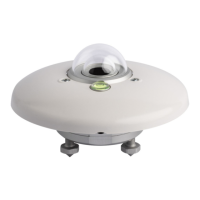LPS10
- 7 -
V1.0
4 INSTALLATION
• The pyranometer must be mounted in an easy-to-reach location in order to clean
the dome regularly and carry out maintenance. At the same time, make sure that
no buildings, constructions, trees or obstructions exceed the horizontal plane where
the pyranometer lies. If this is not possible, select a site where obstructions in the
path of the sun from sunrise to sunset do not exceed 5 degrees of elevation. N.B.:
The presence of obstructions on the horizon line affects significantly the
measurement of direct irradiance.
• The pyranometer must be located far from any kind of obstruction, which might re-
flect sunlight (or sun shadow) onto the pyranometer itself.
• The mast height does not exceed the pyranometer plane to avoid measurement er-
rors caused by any reflection or shadow of the mast itself.
• In compliance with ISO TR9901 standard and WMO recommendations, if the pyra-
nometer is used without the solar radiation protection screen, it must be positioned
so that the connector points to the North Pole, if the instrument is used in the North-
ern Hemisphere, and to the South Pole, if used in the Southern Hemisphere. In any
case, it is better to follow this recommendation even when the screen is used.
• For fixing, use the two M5 or the two M8 holes in the lower part of the pyranome-
ter. For an accurate horizontal positioning, adjust the height of the two lower feet
with knurled ring, using the bubble level integrated in the pyranometer.
Note: for horizontal positioning it is preferable to use the bubble level also in mod-
els equipped with a tilt sensor, as it is more accurate; use the tilt sensor for posi-
tioning monitoring after installation. Use the tilt sensor for installation only if the
pyranometer must be positioned tilted with respect to the horizontal plane.
• It is preferable to thermally insulate the pyranometer from its mounting bracket by
securing it not with the base directly in contact with the support plate, but by leav-
ing a layer of air in between (for this purpose, always use the feet even if the in-
stallation is not horizontal), while at the same time ensuring that there is good
electrical contact to ground.
Fig. 4.1: position of fixing holes and bubble level

